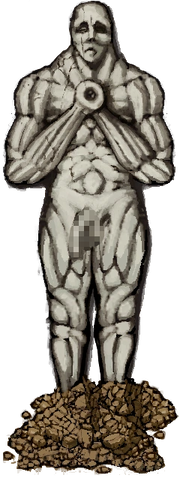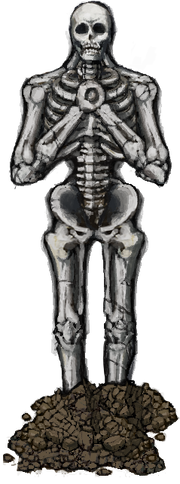Alll-mer
| Alll-mer | |
|---|---|
| Aliases | The Ascended One Savior of Mankind |
| Relatives | Unnamed false God (father, first origin story) Unnamed virgin mother (mother, first origin story) Vitruvia (creator, second origin story) Sulfur God (other half) |
| Biographical information | |
|---|---|
| Date of birth | Year 0 (as an Ascended God) |
| Place of birth | Jettaiah, Eastern Sanctuaries (as a human) Ma'habre (as an Ascended God) |
| Physical description | |
|---|---|
| Gender | Male |
| Species | Ascended God Human (formerly) |
| Warning! Spoilers ahead!
Proceed at your own risk! |
| Warning! Nudity ahead!
This page contains depictions of genitals and / or sex. |
Alll-mer is an Ascended God in Fear & Hunger and Fear & Hunger 2: Termina. He is one of the only two known mortals to have ascended to rival the Old Gods due to his status as a half god and half man.
Lore
Alll-mer, now worshipped as a God, was not always the divine being he is today. He was born as a mortal man in the city of Jettaiah, located within the Eastern Sanctuaries. Raised by a virgin mother and sired by a 'False God,' Alll-mer was of humble origins. He gained popularity and began to rise to prominence through his teachings, which gathered his twelve Apostles to possibly bring forth a New World Order, later referred to as the Old World Order by the New Gods.
As Alll-mer's power grew, corrupt kings and sultans across the Eastern Sanctuaries began to take note of his influence and felt threatened by his ideal world that united people under different religions and gods. He was sentenced to death by crucifixion, marking the beginning of a new calendar with his death in the Year 0. Upon dying, he ascended to Ma'habre and became a God. His mortal remains were laid to rest within the Ancient Tomb near the ancient city of Ma'habre.
Alll-mer eventually returned to his Apostles and led them in his plan to save humanity from the cruelty and tyranny of the Kings and Sultans. As an Ascended God, he killed the Kings and Sultans and brought forth a New World Order, with himself as the center of worship. The bloodbath that ensued shook the world order and demolished the worship New Gods of the time had been enjoying. His tenets are still observed and followed by many, including the Eastern Sanctuaries, Jettaiah becoming a holy city, the Kingdom of Rondon, Abyssonia, Kingdom of Bohemia, Vatican City, and Kingdom of Bremen. This New World Order eventually became the Old World Order, which was later supplanted by the Fellowship of the New Gods in the Year 809.
Alll-mer has another origin story, written by Enki Ankarian in his Skin Bible of Alll-mer. According to this version, Alll-mer was created by a master architect named Vitruvia, who designed him to be the ultimate human being after noticing imperfections in her previous designs. He was born in the Year 0, suggesting that he immediately began working on his New World Order and displacing the Sultans and Kings of old. Though the two stories share similarities, they are still distinct.
His ascent to godhood is intricately linked with the emergence of the Sulfur God, a relatively forgotten deity that dates back to ancient times. As Alll-mer ascended to the divine realm, he expelled his subconscious, which was steeped in hatred, into the depths of the sulfur pits. This event gave rise to the Sulfur God.
Alll-mer's religious cult has experienced a resurgence in popularity in modern times and has become the default religion in many parts of the world. The Fellowship, on the other hand, has largely been forgotten by the common people. Even the other Old Gods have not regained as much popularity as Alll-mer, who remains a prominent figure in the religious practices of many. Dark Priests, in particular, seem to favor his image above those of other Old Gods, at least to the public eye.
Like other higher deities, Alll-mer possesses a variety of supernatural phenomena associated with his presence. These include walking on water, altering the fabric of reality to a limited extent (such as changing water into wine or multiplying loaves of bread), and manipulating blood to create portals or weapons, among others. Those who have a strong affinity with him through faith may be able to access some of these abilities.
The iconography associated with Alll-mer exhibits significant variations influenced by the cultural perspectives of its worshipers. In Europa, the god is commonly portrayed as a muscular, bald-headed, caucasian male. In stark contrast, the Eastern Sanctuaries offer distinct depictions of Alll-mer that harken back to his mortal origins. In these portrayals, the deity is depicted as slender, reflecting a more delicate physique compared to the robust Western depiction. Furthermore, Alll-mer is depicted with long hair, closer to what he was before ascending and losing all his bodily hair. His facial features often resemble those of the region.
The God's runic symbol is the cross, the very thing that he died on. His date of birth is celebrated as a holiday.
Special 'Interaction'
If the player manages to find his corpse in the Ancient Tomb near Ma'habre, they can use the skill, Necromancy, on the corpse itself, causing his penis to become erect.
Trivia
- His tale appears to draw inspiration from the narrative of Jesus Christ, who was born of a virgin mother and fathered by God, gathered a group of twelve apostles to disseminate the message of God, was crucified, died for humanity's transgressions, rose from the dead, instructed his disciples to continue spreading His and God's teachings, and ultimately ascended to the Kingdom of Heaven to join his Father.
- However, unlike Jesus Christ, Alll-mer employs his power to slaughter all of the monarchs and ruling bodies, establishing a new world order in which he is revered as the primary object of worship.
- Although All-mer was previously recognized as an Old God in Fear & Hunger, the game series has since reassigned him to another divine category as an Ascended God.
- In Fear & Hunger 2: Termina, when a character casts Alll-mer's spells, the sound that accompanies it is a modified rendition of the Gregorian Chant "Gaudeamus," which is frequently employed during Marian Feast celebrations.
- One of the paint buckets found in Tunnel 1 is labeled "Alll-mer turquoise".
- While Miro Haverinen has forgotten the ultimate inspiration behind Alll-mer's name, he has confirmed the third "L" was added solely to make the name seem more interesting and mysterious.[1]
Gallery
References
Testing





